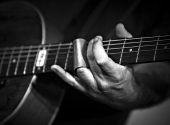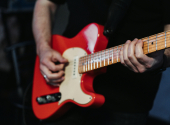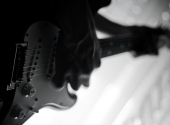
(Un)usual Guitar Techniques #8: Legato
In the last episode of our series on guitar techniques, we covered tapping and explored the widespread term "shredding". We'll stick with fast playing today, but we'll turn our attention back to the left hand. And again, we won't really need the pick. We're going to talk about the legato technique, which complements tapping and forms the basis of all super-fast fingerboard runs.
One could probably argue that legato is not a technique, but as the definition says – just notes played in a smooth, continuous way. However, here we come up against the fact that some instruments have legato sort of in their nature and it is the primary way of playing the instrument. But with the guitar, you usually learn to play with the pick first, where the individual notes are clearly defined by the strikes of the pick against the string. It's only when you want to play a really fast run of consecutive notes or give your licks more flow and smoothness that the so-called legato technique comes into play.
Hammer-on, pull-off and slide
The electric guitar is different from the acoustic guitar in many ways, and one of the major differences is its much greater sensitivity. Thanks to the amplification of the sound by the pickup, things that would be lost or not heard at all when playing an acoustic can make their way into the amp. This often causes complications, of course, because we have to dampen the various overtones, unwanted noises or rattling strings much more thoroughly. At the same time, however, it allows us to play the tone by relatively gentle contact with the string, which is what the legato technique exploits.
The Legato technique consists of several ways of playing a note with the left hand without striking the string with the pick. In the first of these, called hammer-on, the note is played by striking the string on the fingerboard. In tapping, we use the fingers of the right hand, but you can use your left hand too. Usually, you only strum the first note on the string with the pick and play the other notes just by putting your fingers on the fingerboard.
The second component of the legato technique is the so-called pull-off, where you play the note as your finger leaves the string. It's a kind of light strum, you pull the string down a little bit and let go.
Then there is the slide, or playing a note by sliding down to it from another note. You can use this especially when connecting the individual "boxes" on the fingerboard. By combining these three elements, you can achieve long flowing melodic lines, and some guitarists even manage without a pick altogether.
A few tips to get you started
When you decide to try playing legato, it helps to start on a guitar with thinner strings that are as low as possible above the fingerboard. This is because you won't need that much strength to make the notes sound good. It's important to keep your left hand relaxed and your fingers as close to the strings as possible to minimise the energy required to hammer-on or pull-off. This economical approach will pay off once you start playing a little faster.
The objective is to make all the notes in the run have the same volume and intensity. Therefore, practice scales and pentatonics as you are used to with all fingers in different positions on the fingerboard. Play the first note that you strum with the pick a little softer than when using the picking technique – otherwise, it will be louder than the notes played with the legato and will "stick out".
Most guitarists who use this technique opt for a more distorted rock sound where even subtle strikes on the string can be heard well. You can apply different types of overdrive, and if you use a neck pickup, you will get a thicker sound that goes well with smooth legato playing. But if you gravitate more towards jazz, you can also try a more subtly distorted sound, and that's where the sensitivity of your pickups and the sustain of your instrument become more important.
Where to get inspired?
The legato technique works well for guitarists playing jazz or fusion, as it allows them to add improvisations consisting of long, smooth runs, much like saxophonists do. But you are most likely to encounter it in rock and metal solos, especially the very fast ones.
As with tapping, the Van Halen album released in 1978 was a breakthrough where Eddie used legato in a way that no one had tried before. While guitarists such as Eric Clapton and Jimi Hendrix played legato elements within conventional blues pentatonics, Eddie Van Halen and his followers laid the groundwork for much more technical playing.
Legato is also an integral part of the so-called "shredding", which we discussed in the last episode. This style of playing was developed by Joe Satriani and Steve Vai in the 70s and 80s, and by John Petrucci of Dream Theatre and Brett Garsed in the 90s. We should also mention Allan Holdsworth, who based his solo playing almost exclusively on legato and often very complicated melodic sequences.
After 2000, we have seen the rise of guitarists such as Guthrie Govan, who is extremely proficient in many guitar techniques, and with the advent of YouTube, a specific space was created for a new generation of guitarists to showcase their skills. One of the most popular ones is for example Tom Quayle.
A lot of tones indeed
If you listen to legato solos and improvisations, you will soon get the impression that there are quite a lot of notes... A lot of notes in a relatively small space. It's easy to get discouraged by that because it seems very complicated. Paradoxically, this is where rock and metal guitarists touch on jazz, as part of the technique, at least since Van Halen, has been the search for unusual scales, progressions and harmonies. For lovers of music theory, there is ample opportunity to explore.
Even for those of us who don't like to delve into Doric or Mixolydian modes, legato playing offers plenty of options. For starters, you can use it in classic blues and, like with tapping, play it really slowly. The notes played with legato have a different quality than the classic picking technique, and even common licks and solo sequences can become smoother and faster using legato.
Do you like crazy fast guitar solos? And who do you think is better, Satriani or Vai? Let us know in the comments!
If you have found an error or typo in the article, please let us know by e-mail info@insounder.org.





